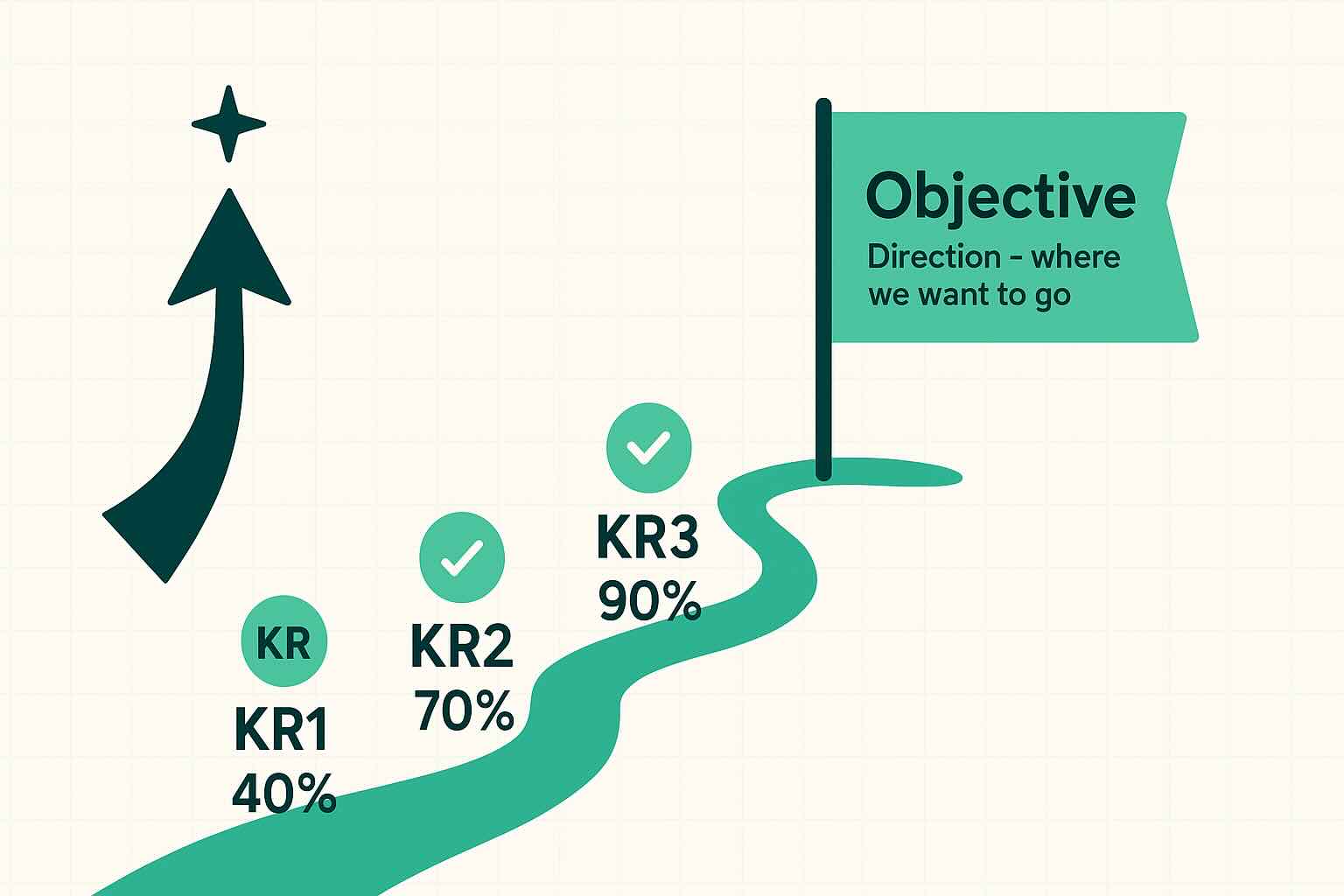What Are OKRs (Objectives and Key Results)? A Complete Guide for Businesses
If you’ve heard the term OKRs tossed around in leadership meetings, strategy workshops, or LinkedIn posts, you’re not alone. The Objectives and Key Results framework has become one of the most widely adopted goal-setting methods in modern organizations — from Silicon Valley startups to global enterprises.
In this article, we’ll explore exactly what OKRs are, where they came from, why and how the OKR system works, and how OKRs can transform your business. We’ll also cover the role that OKR consultants play in helping organizations get them right the first time.

What OKRs Are
OKRs combine a qualitative Objective with quantitative Key Results that indicate success. Objectives are inspirational and directional; Key Results are specific, measurable outcomes that prove whether progress has been made.
- Objective: Are the direction (tnat is where we want to go), they should be inspiring, memorable, and easy to communicate.
- Key Results: Numeric or clearly verifiable endpoints that define success. They are like milestones that indicate if we have made progress in our desired direction.
Example — SaaS Retention
- Objective: Delight customers with a best-in-class support experience.
- Key Results: Raise NPS to 65+; reduce monthly churn from 12% to 8%; resolve 90% of tickets within 24 hours.
Example — Marketing Expansion
- Objective: Build brand awareness in core European markets.
- Key Results: Secure 50 press mentions; grow LinkedIn followers by 25%; reach 15% aided recall in quarterly survey.
Example — People & Culture
- Objective: Strengthen employee engagement.
- Key Results: Lift engagement score from 72 to 80; achieve 90% participation in pulse surveys; run four team-learning events with 85% attendance.
Where OKRs Came From
The approach was first developed Andy Grove, one of the co-founders of Intel in the 70s. From there the OKR system has gained traction in tech and beyond because it translates strategy into focused, measurable outcomes. Organizations use OKRs to keep teams aligned on what matters most and to review progress frequently enough to adapt.
- Example: A semiconductor firm uses OKRs to coordinate a strategic shift to a new product line.
- Example: A scaling search company aligns dozens of teams to a few enterprise-wide priorities.
- Example: A global foundation measures impact across programs with objective, comparable results.
Why Organisations Use OKRs
Leaders adopt OKRs to create clarity, alignment, and measurable outcomes without drowning teams in process.
Clarity and Focus
- A startup limits itself to three company priorities to avoid spreading resources thin.
- A sales organization concentrates on one strategic segment instead of chasing every lead.
- A non-profit channels 80% of fundraising to its highest-impact program.
Alignment Across Teams
- Marketing OKRs tie directly to product launch milestones.
- Customer support OKRs move the same satisfaction metrics the executive team tracks.
- Hiring and onboarding OKRs in HR support headcount targets in engineering.
Measurability and Learning
- “Improve onboarding” becomes “reduce time-to-productivity to 14 days.”
- “Grow social” becomes “reach 10,000 followers and 5% engagement rate.”
- “Enhance quality” becomes “cut defect rate below 1% with zero Sev-1 incidents.”
How an OKR Cycle Works
Most organizations set OKRs on a quarterly cadence, with annual alignment on strategic priorities. The rhythm is simple but powerful: set objectives, align teams, check in often, and review to learn.
- Set company objectives: Choose a small number of priorities that express the strategy.
- Align team OKRs: Create line-of-sight from teams to company outcomes; avoid copy-paste cascades.
- Run frequent check-ins: Weekly or bi-weekly touchpoints focus on outcomes, blockers, and next bets.
- Score and reflect: Grade Key Results, analyse what drove movement, and capture improvements for the next cycle.
Applications In Practice
- A retailer entering a new country aligns marketing, logistics, and customer service to one market-entry objective with shared metrics.
- An engineering org rolls out a new security baseline, with KRs on coverage, time-to-remediate, and audit pass rates.
- A hospital improves patient experience by targeting throughput (triage times, time-to-bed, discharge efficiency).
Common Misconceptions
OKRs are not task lists: “Hold weekly meeting” is a task; “resolve 90% of tickets in 24 hours” is a Key Result.
More OKRs aren’t better: Spreading a team across a dozen objectives kills focus and accountability.
OKRs don’t replace KPIs: KPIs monitor business-as-usual; OKRs drive step-change outcomes. Most companies need both.
How External Facilitation Helps
Organizations often benefit from expert facilitation when they’re new to OKRs or need to reboot. External coaches help align leadership, raise the quality bar on Objectives and Key Results, and establish the check-in and review habits that sustain momentum.
- Alignment workshops: Converge on a few priorities with crisp, outcome-based language.
- Drafting support: Turn vague intents into measurable Key Results with clear owners and data sources.
- Cadence design: Build weekly/bi-weekly check-ins and end-of-quarter reviews that people actually value.
Writing Better Objectives
- Make them specific to your customer or strategy (e.g., “become the easiest vendor to onboard in our category”).
- Keep them human and memorable; avoid jargon and composite goals.
- Stress test with “would a new hire understand this in 30 seconds?”
Writing Better Key Results
- Use numbers or unambiguous yes/no criteria tied to a reliable data source.
- Prefer outcomes (user behaviour, quality, speed, economics) over activity metrics.
- Balance leading indicators (e.g., trial-to-paid conversion) with lagging ones (e.g., gross retention).
A Complete Example
Objective: Become the benchmark for customer experience in our market.
- KR1: Lift CSAT from 82% to 90%.
- KR2: Raise repeat purchase rate from 40% to 55%.
- KR3: Cut average resolution time from 48 hours to 24 hours.
Notice how each KR is measurable, time-bound, and clearly linked to the experience strategy.
Getting Started
- Run a two-team pilot for one quarter to build muscle before scaling.
- Limit company objectives to three or fewer; keep 2–4 Key Results per objective.
- Schedule short, regular check-ins and a learning-oriented review at quarter end.
Closing Thought
OKRs work when they’re simple to understand, consistently reviewed, and tightly tied to strategy. With a clear cadence and strong habits, teams focus on what matters and learn faster—cycle after cycle.
